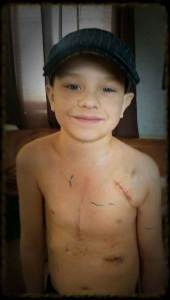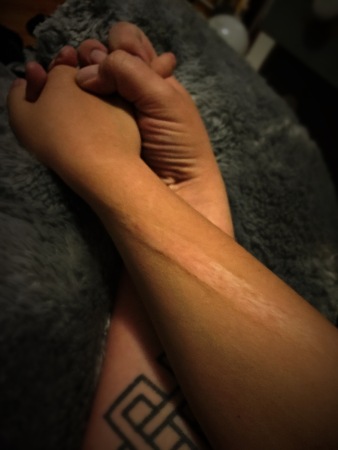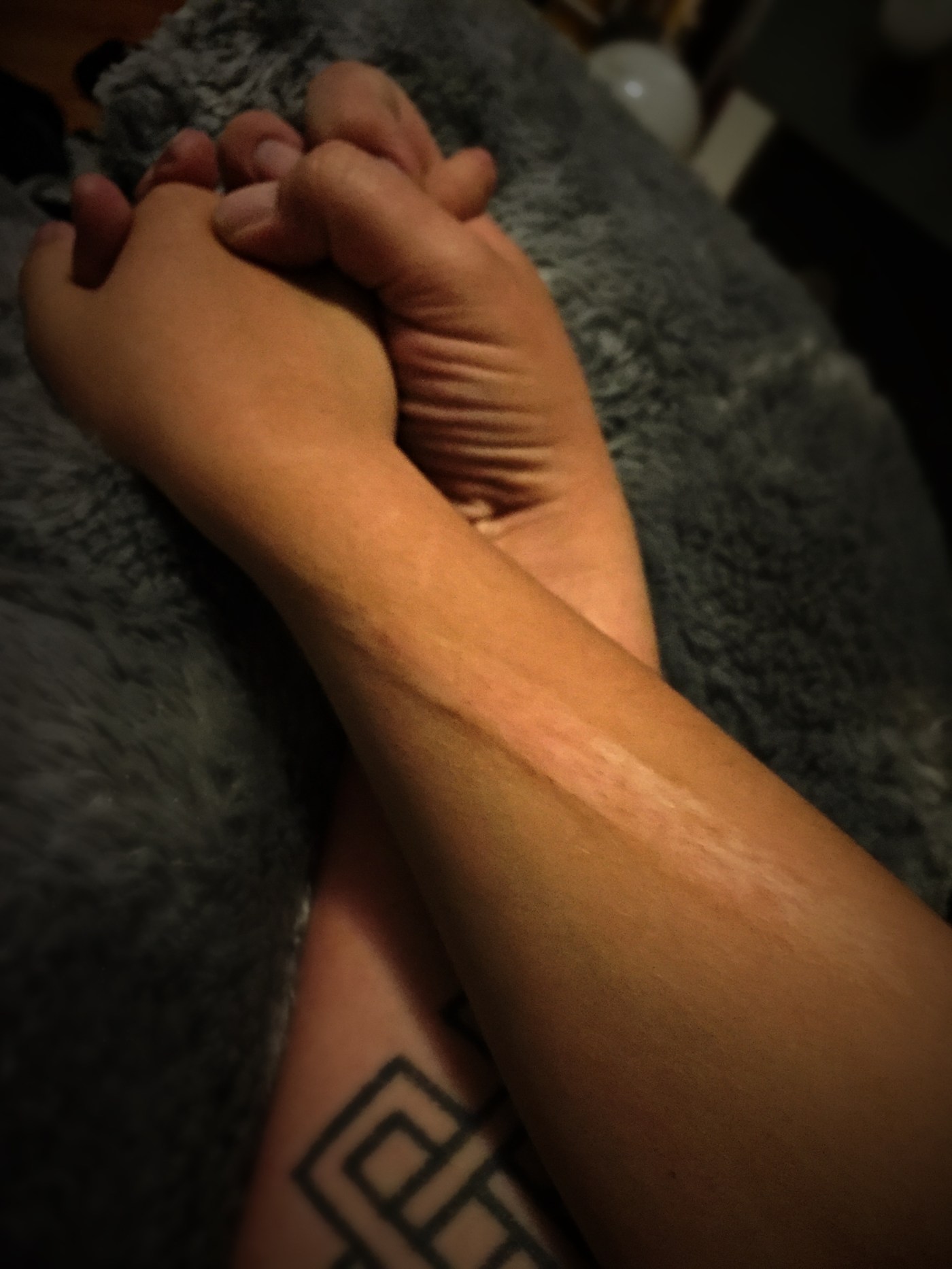 This week, the online world was introduced to a young man named Carter Gentle, a brave little boy with a congenital heart defect who has undergone multiple open-heart surgeries, and when looking at his chest riddled with scars, Carter cried when seeing them out of the fear of being judged by others as hideous or ugly. Carter’s dad, though, acted nobly by sharing this story online, so that his son could hear from the rest of the world how beautiful he is because of the stories his scars tell us about uncommon strength. In less than 24 hours, Carter had over half a million people reassure him that his scars were not only nothing to be ashamed of, but stories of which he should be proud. As of this writing, that number is in the millions.
This week, the online world was introduced to a young man named Carter Gentle, a brave little boy with a congenital heart defect who has undergone multiple open-heart surgeries, and when looking at his chest riddled with scars, Carter cried when seeing them out of the fear of being judged by others as hideous or ugly. Carter’s dad, though, acted nobly by sharing this story online, so that his son could hear from the rest of the world how beautiful he is because of the stories his scars tell us about uncommon strength. In less than 24 hours, Carter had over half a million people reassure him that his scars were not only nothing to be ashamed of, but stories of which he should be proud. As of this writing, that number is in the millions.
As Carter’s story spread, others came forward to share their scar stories, as well as how they came to terms with what those scars represented to them. The sharing of this story has given way to a crucial conversation on the definition of beauty as it relates to personal “flaws,” and more importantly, how we, as a society, allow our culture to define what is flawed. These conversations have been ongoing in my family for the last seven years or so, thanks to one event that could be considered any parent’s nightmare.
My wife and I have a special code for emergencies: if I need to call immediately, she calls twice in a row. We’ve always agreed on this rule, so on New Year’s Eve 2007, when my phone started vibrating for the second time during a meeting at work, my heart jumped. I excused myself from the meeting, just as I had practiced in my head before, when wondering how I might react in such an emergency.
As I lifted the phone to my ear, I heard sobbing. It wasn’t typical sobbing, as though hearing news of a loved one’s passing. This was dread—pure, unfettered terror. “You need to come home,” my wife urged, “NOW!”
I ran out of the building without so much as a word. On the drive home, another one of her calls diverted me to our doctor’s office, where I found my wife in the parking lot, huddled in the back of our minivan, trying desperately to console our six-month-old son, who was screaming the most terrifyingly gruesome cry a parent can ever hear.
Ten minutes earlier, my wife and son were at home, getting ready for an uneventful evening at home to ring in the New Year. My wife had just plugged in her curling iron to do her hair even though we were staying in, because she wanted to at least “look the part,” even if we weren’t going anywhere. My son was in his walker, wheeling around the house as usual and following Mom around, but in an instant, he turned and headed down the hallway.
Lord knows what was on the floor that jolted one of his wheels ever so slightly, but it was enough, veering him off course, up over a transition strip in the doorway, and into the bathroom, where a dangling cord aroused his wonder. As curious babies with flailing arms will, his little hand reached for it, and as he pulled on it, the hot curling iron came down on his neck, instantly searing his flesh, causing his shoulder to shrug in reflex, pinching it in place as it blistered his neck. Then, his shoulder let go long enough for the iron to fall to rest, scorching his forearm, which was where my wife found it after sprinting to his side.
This all happened in the span of about 10 seconds or less, but we spent the next several days in the hospital with our little boy, sedated, as we changed dressings every few hours and comforted his cries each time his pain meds wore off, doing our best to keep ourselves together and remain strong for his sake. We were visited by several professionals over this period, including a surgeon, who warned us that skin grafts would likely be in our son’s future, and a nurse, who warned us that others may probe our story to determine if the accident was caused by negligence, or worse, intentional harm.
Over the next several months, our little boy endured bandage changes and multiple baths throughout each and every day, while we endured the self-guilt and pain of watching our precious little one suffer almost endlessly. Throughout these dark days, it seemed like nothing good could ever come from such a traumatic event.
That is, until something did.
During what we had hoped was the definitively final visit with the plastic surgeon, the doctor told me that my son would not need skin grafts, that he would likely grow up with very little scarring, and that he could choose to have surgery to remove it later in life, if so desired. I remember this day clearly, because it was the first and only time I have ever cried in a doctor’s office, and it was the last time I hugged a surgeon. I rushed my son to my wife’s work, at a daycare, where I shared the news with her, resulting in mutual tears of joy, which led to about 20 preschool children and toddlers giving us all a group hug in revelry.
As my son grew older, he eventually started questioning the giant scar on his forearm, as well as the one behind his ear. I always asked, “Do you want to know the truth, or do you want to tell a story?” Choosing the latter, my son told others he got the scars from a sword fight with skeleton pirates while riding a long-neck dinosaur, or that it happened during an epic light saber battle with meddling Jedi (in our house, we align with the Sith).
In a profound twist, though, in each story, he always added that it happened while protecting his family.
 In the last 800 words or so, my son’s scars told a story, because that’s what scars do. Every scar is one of life’s tattoos, presenting the potential to tell the world of the difficulties we have endured and persevered, before coming through the other side of tragedy, healed and stronger than ever before.
In the last 800 words or so, my son’s scars told a story, because that’s what scars do. Every scar is one of life’s tattoos, presenting the potential to tell the world of the difficulties we have endured and persevered, before coming through the other side of tragedy, healed and stronger than ever before.
Whether our scars are physical blemishes left behind by a harrowing experience, as in the case of my son, a medical necessity, as in young Carter’s case, or emotional scars that go unseen by everyone else, we must realize that the sum of our experiences lead us to become the people we are, and that, by facing difficulties with tenacity, along with the support of those whom we love and love us in return, we have the power to transform what once may have been viewed as a physical defect into a sublimely beautiful bookmark among the pages of our life story.

April 16, 2015 at 10:37 am
Thank you, Josh. This must have been very hard to write, but I am so glad that you did. What a hopeful, healing message that resonated deeply with me.
LikeLiked by 1 person
April 16, 2015 at 12:50 pm
Thank you, Rachel!
LikeLike
April 16, 2015 at 7:58 pm
Wow. How horrifying that must have been for your wife and you. It’s scary how things can happen so quickly.
Wonderful message here.
LikeLiked by 1 person
April 16, 2015 at 8:03 pm
Thank you! What was horrifying and seemed to last an eternity has turned into a story about perseverance and strength. It used to be a lot harder to tell this story, but my son is actually proud of it now.
LikeLiked by 1 person
April 16, 2015 at 8:05 pm
Nice.
Cliche is true – time heals wounds. And in this case turns them in badges of courage.
LikeLiked by 1 person
April 17, 2015 at 9:11 am
Wow…just…wow! An amazing piece of writing, my friend, and an amazing story to share.
LikeLiked by 1 person
April 17, 2015 at 9:16 am
Thanks for reading!
LikeLike